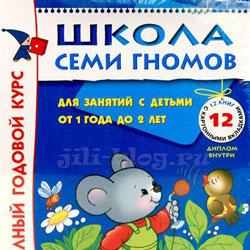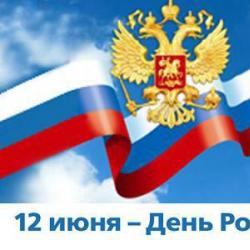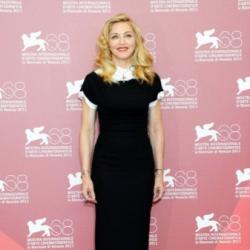Public holidays in Russia. Weekends and holidays. Church holidays: dates, explanations and traditions What holiday is the 8th
Holidays are special dates in our lives when people honor each other, their family and friends, and remember any special days on which memorable events happened.
Some of them are celebrated throughout the Earth. Others - in individual states, others - in groups and families. Holidays can be religious, state, folk, sports, professional and others.
By now, there are more and more public holidays. People love them, celebrate them and have fun. Let us describe the main dates that are celebrated in our country.
Holidays in Russia
Holidays in Russia are an inextricable part of the culture, history and spiritual life of the state. Over time, they turn into a tradition for people. These are celebrations that are celebrated on the same days every year. They are dedicated to events of various nature. Public holidays in Russia are those that have state status. Moreover, the days on which they fall are weekends.
Holidays play an important role in bringing people together, instilling a sense of patriotism, and demonstrating the strength and importance of the state on the world stage. In honor of them, symbols of state power, heroes of the nation are honored, distinguished citizens are awarded, acts of amnesty are issued, and so on. Since the depths of centuries, we have preserved the harmony and unity of the people on these special days. Government officials appear in the stands, ceremonies and awards are held.
Weekends and non-working days
An official holiday makes the day a non-working day. This procedure is carried out differently in different countries. In some states, special regulations are issued, in others, there is a legal document for each day, in others, general norms are established that regulate management.
Public holidays in Russia are defined in the Labor Code, in Article 112. They are: New Year holidays, Christmas, Defender of the Fatherland Day, Victory Day, Russia Day, National Unity Day, International Women's Day, Labor Day.
If a day off and a non-working day coincide, the first is transferred to the next working day. There may be other transfers. If, for example, a holiday is on Tuesday, then Monday will be a day off, and the Saturday before it will be a working day.
New Year
The New Year begins on the first of January. For the holiday, the Christmas tree is decorated, many delicious dishes are prepared, children expect fabulous gifts and surprises from Father Frost and the Snow Maiden. The girls sit down to tell fortunes. Many people make cherished wishes on the night from December thirty-first to January first and believe that they will certainly come true.
This holiday takes its origins from the time when agricultural work began on the Tigris and Euphrates rivers. The event was celebrated for twelve days, and it was impossible to work then. Later, Jews, Greeks and Europeans adopted this custom.
It is known that in Rus' the New Year was celebrated with the beginning of spring, when nature awakened. But the custom gradually ceased to exist with the transfer of the New Year to the first of January.
Russia Day

Juneteenth has been a holiday since 1990. The day has a special place and meaning. A new generation has emerged that did not live in the Soviet Union. Russia Day has become an expression of patriotism, people are proud of their country and demonstrate it.
But at first this holiday was not accepted by the people; it was considered an ordinary day off. Today it has turned into a symbol of the unity of the people, freedom, peace, independence and harmony.
Unity of the people
Since 2005, Russian public holidays have been supplemented with a new one, which is known as National Unity Day, celebrated on the fourth of November.
On October 22, according to the old calendar of 1612, the people's militia under the leadership of Minin and Pozharsky took Kitay-Gorod by storm. Dmitry Pozharsky entered there with the icon of the Kazan Mother of God. A few days later, the interventionists signed a capitulation and surrendered.
In 1649, by decree of the tsar, the day of the icon of the Kazan Mother of God was established, which was declared a public holiday and was celebrated until 1917.
The same date (the twenty-second of October according to the Julian calendar, or the fourth of November according to the Gregorian calendar) was again chosen as a national holiday in Russia - National Unity Day.
Men's Day
The twenty-third of February is Defender of the Fatherland Day. Women congratulate all men who have served or are serving in the army or other law enforcement agencies. This holiday demonstrates love for the Motherland, readiness to defend it and, if necessary, defend it.
In 1918, when the working class learned that the Fatherland was in danger, the formation of the Red Army began. And on February 23, she already repulsed Germany near Pskov and Narva. This day is considered the birth of the Red Army.
Now there is talk about celebrating Defender of the Fatherland Day on May 6th, the day of St. George, who patronizes wars. However, the twenty-third of February was and remains a holiday for men, which is celebrated in military traditions.
Women's Day
The favorite holiday of women of all ages is March Eighth. On this International Women's Day, the stronger half of humanity showers the weaker sex with gifts, kisses and flowers. Women buy and wear their best clothes to look sunny, happy and cheerful in the first days of spring.

It’s not often that anyone thinks about the history of the holiday. It all started relatively recently, and the reason was not so rosy. On March 8, 1857, women in New York staged a demonstration. They demanded better working conditions and equal rights compared to men. The procession was then dispersed, but the women were so noisy and trumpeted their action so much that as a result it was nicknamed Women's Day.
At an international conference held soon, it was declared as International Women's Day of Solidarity.
Since 1913, it began to be celebrated annually. And in 1965, the holiday was declared a non-working day in the Soviet Union.
However, women have been revered before in history. For example, in the Roman Empire a day was also dedicated to them, when ladies received gifts from men, and the latter surrounded them with their care, attention and love.
Even slaves then received gifts and could rest. The women dressed in the best clothes and decorated their heads with wreaths.
may Day
Spring and Labor Day (previously it had a different name) appeared at the end of the nineteenth century, when Chicago workers went on strike and demanded an eight-hour working day. It lasted fifteen hours. Six workers and eight policemen died during the brawl. Several more people were sentenced to death. In memory of them, in Paris, the Congress of the International declared the first of May as the Day of Solidarity of Workers around the World.
After the October Revolution of the seventeenth year, the Spring and Labor Festival began to be celebrated in our country.
The first of May became a mandatory event. Workers walked along the main street with flags and banners. In Moscow, a demonstration takes place on Red Square.
Currently, the May Day holiday has ceased to be political. It was renamed. Nevertheless, trade unions, parties and various movements hold actions on this day, speaking under different slogans.

Day of Victory, Memory and Sorrow
Russian public holidays do not end in this fifth month of the year. May is rich in them. The ninth of May is Victory Day of the USSR over Nazi Germany. In the West, the holiday is celebrated on the eighth.
The day became a non-working day only in 1965, in honor of the twentieth anniversary of the Victory. Military parades are held annually on Red Square. Wreaths are laid at the monuments. Veterans meet and concerts are held in honor of the Victory.
The “St. George Ribbon” and “Immortal Regiment” campaigns have recently begun. Millions of people not only in Russia, but also abroad attach the Victory symbol to their clothes or cars. Having taken photographs of their relatives who died during the Great Patriotic War, people walk along the central streets of cities, demonstrating that nothing is forgotten and no one is forgotten.
Such actions are very relevant and necessary, since in Western countries attempts to falsify history are intensifying every year. Textbooks for schoolchildren are being rewritten, facts are being distorted. Most young Americans are confident that it was the United States that won World War II, and not the Soviet Union. Half of the Japanese believe that the Russians dropped the atomic bomb on them, not the Americans. The so-called developed European countries are trying in every possible way to reduce the role of the USSR in the victory over fascism. Therefore, mass actions of ordinary people show such politicians the futility of their attempts.
The twenty-second of June is celebrated on a different day. More than seventy years ago the war began. The Day of Remembrance and Sorrow was established on June 8, 1996.
In Russia and other neighboring countries, mourning events are held for those killed during the war. National flags are flown at half-mast, and entertainment programs on radio and television are abstained.
Then war came knocking on every family’s door and disrupted peaceful life. At the cost of many millions of lives, the Soviet people defended their native land. Husbands, fathers and children defended their loved ones and defeated the Nazis.
The Day of Remembrance and Mourning demonstrates that the exploits of soldiers, women and children on the home front are not forgotten. The new generation is proud of the resilience and heroism of their ancestors.
The twenty-second of June will forever remain the Day of Remembrance of the People for all those who died during the bloody war. Eternal glory to everyone who died on the battlefield, died in hospitals or in concentration camps!

Other holidays
There are holidays that have been celebrated in Russia since the times of the Soviet Union. In others, the dates in honor of which they were established were changed. For example, Land Reclamation Day in Russia is celebrated in the same way as under Soviet rule. Also celebrated, for example, Civil Aviation Day, Day of Geodesy and Cartography Workers, Meteorologist, Geologist, even Students and so on are also celebrated on the same dates as in the Soviet Union. But Russian Science Day is celebrated on a different day. There are holidays that were not celebrated in the USSR, but were established in modern Russia. These include Military Translator Day. It has been celebrated on May 21 since 2000 and was proposed by the Military Institute.
In 1999, the Day of Russian Science was established. It is celebrated on February 8, the day of the founding of the Russian Academy of Sciences by decree of Peter the Great in 1724.
Science Day in the Soviet Union was celebrated on the third Sunday in April, when Lenin drew up the “Outline of a Plan for Scientific and Technical Work” in 1918, thereby recognizing science. And today, many scientists celebrate their holiday the same way as it was in Soviet times.
Armed Forces Holidays
The navy, air force and other armed forces have their own professional holidays. In honor of particularly memorable events, days of military glory are established. Even conscripts have a holiday, which is celebrated on November 15th.
The ground forces celebrate their day on the first of October.
Fleet
The country celebrates the Day of the Northern, Baltic, Pacific and Black Sea Fleet of the Russian Navy.

On April 8, 1783, Catherine the Second signed a decree on the formation of a fleet on the Black Sea. The main reason was the annexation of Crimea to Russia. And on May thirteenth, eleven ships of the Azov flotilla entered Akhtiar Bay. Later, the hero city of Sevastopol was built there. The Black Sea Fleet fought well with Turkey, France and other states. But he lost in the Crimean War. Russia lost its right to be in the Black Sea, and then regained it again.
On the thirteenth of May the Day of the Black Sea Fleet is celebrated. The Russian Navy marks the dates of other fleets as well.
Peter the Great issued a decree on the construction of the first frigate with twenty-four guns in Arkhangelsk, and a century later warships patrolled from the Norwegian to the Kara Seas. However, a full-fledged Northern Flotilla appeared much later. Severomorets carried out scuba diving, transitions from the Arctic to the Far East, and visited the North Pole several hundred times. Therefore, they fully deserve a separate holiday for themselves - Northern Fleet Day, which is celebrated on the first of June.
The appearance of the Baltic Fleet is also associated with the name of Peter the Great. At the beginning of 1701, he ordered the construction of cannon ships on Lake Ladoga. And soon they, located at the base in Kronstadt, were already repelling attacks from Sweden.
In addition to military operations, sailors carried out inventions, expeditions, and discoveries. The headquarters of this fleet is located in Kaliningrad, but its main base is in the Leningrad region.
Baltic Fleet Day is celebrated on the eighteenth of May.
On May 21, 1731, the Empress ordered the settlement of Okhotsk and the establishment of a shipyard and marina on it. The first Far Eastern division was created. On this day and today, congratulations are given to the military personnel of the Pacific Fleet, which includes strategic submarines, nuclear, missile, diesel, surface ships, missile-carrying anti-submarine aircraft, ground and coastal forces.
Landing
The Airborne Forces in Russia are called “blue berets” and “winged infantry”. The paratroopers themselves call themselves “Uncle Vasya’s Troops.” Fighters of this type of military are associated with reliability and masculinity.
The second of August is celebrated as Airborne Forces Day - Airborne Forces Day. It was then, in 1930, that a unit of paratroopers with parachutes was dropped for the first time.
This service is difficult and dangerous, but paratroopers are brothers who help each other and are able to protect a comrade from bullets.
The purpose of the Airborne Forces is to place paratroopers in places where other troops simply cannot be. These are, for example, hot spots and trails in Afghanistan and Chechnya.
The history of the Airborne Forces was made up of the courage, valor and honor of its heroes. Millions of Russians have completed this service. Therefore, the holiday has become truly national.
Aviation
Aviation Day is celebrated on the third Sunday in August. On this date, demonstrations and various performances of the air force are held.
Most people have used aviation services at least once in their lives and been on a passenger plane. Airplanes transport huge numbers of passengers around the world every day. On February 9, 1923, an air fleet appeared in Russia, which began to transport people on official and personal business, as well as mail and various cargo. Civil Aviation Day in Russia began to be celebrated on this day. Pilots, flight attendants, dispatchers and technical workers receive congratulations. They are the ones who provide air traffic in the country when hundreds of aircraft take to the air.
Ministry of Internal Affairs
All employees of the Ministry of Internal Affairs of the Russian Federation celebrate their holiday - the Day of the Internal Troops of the Ministry of Internal Affairs of Russia - on March twenty-seventh. However, this is a working day.
The holiday was established in 1996 by presidential decree. Historically, the day is associated with the creation of the Internal Guard by decree of Alexander the First in 1811.
The role of internal troops can hardly be overestimated. Employees protect the peaceful lives of people, ensure the protection of strategic objects and transport links.
On this day, senior officials congratulate their subordinates and award titles, awards, gifts, certificates and gratitude to those who distinguished themselves during their service.
Radio and print
On May 7, Russian physicist A.S. Popov showed the world how radio works. On this day they began to celebrate Radio Day. But for the first time it was celebrated only on its thirtieth anniversary in 1925. The day has become a full-fledged holiday since 1945.
Many innovations and innovations have been invented since then. Radio Day is celebrated on television, radio broadcasting, mail, and is observed by all those who broadcast about important events taking place in the country and the world.
However, on the seventh of May the holiday is celebrated specifically in Russia. On February 13, 1946, a radio broadcast took place at the UN for the first time. It was then that International Radio Day was established.
In 1991, it was decided to celebrate the thirteenth of January as Russian Press Day. The date is associated with 1703, when the first issue of the printed newspaper Vedomosti was published. This holiday was established to replace Soviet Press Day, which took place on May 5, when the first issue of the Pravda newspaper was published. In Belarus it is celebrated on May 5th.
Religious holidays
People of different faiths and confessions coexist in Russia. Christians, Muslims, Jews - they are all citizens of one country. Nevertheless, the vast majority of the population are Orthodox Christians. Many religious solemn dates are celebrated in Russia. Among them are Christmas, Easter and the Day of the Baptism of Rus'.

Christmas
This is one of the main holidays for believers. Catholics celebrate this day on the twenty-fifth of December, while the Russian Orthodox Church and others who use the Julian calendar celebrate it on the seventh of January.
No one has yet been able to accurately determine the date of Jesus’ birth. Most likely, he was born between the seventh and fifth years BC. In 221, Julius Africanus first indicated the date of birth of Jesus - the twenty-fifth of December.
Easter
The Resurrection of Christ, or Easter, is the main religious holiday for Christians. According to legend, on this day Jesus Christ rose from the dead. Easter is celebrated on the first Sunday after the spring full moon, namely after the vernal equinox.
On the twenty-eighth of July the memory of Prince Vladimir is honored. In 2010, this day became a new memorable date.
In 988 the Baptism of Rus' took place.
Prince Vladimir, or the Red Sun, first ruled the land of Novgorod. But soon, as a result of strife, he became a sovereign prince. Having taken Chersonesus, Vladimir demanded the hand of Princess Anna from the Byzantine emperors. But when the prince saw her, he suddenly lost his sight. Anna suggested that he be baptized, which Vladimir did, and it was as if he received his sight. He exclaimed: “Now I have seen the True God!” Upon arrival in Kyiv, Vladimir baptized all his twelve sons. After this, he began to eradicate paganism from the hearts of the Russian people.
Since then, in Rus', and then in Russia, they began to honor Christianity and believe in Jesus Christ.
Despite the large number of holidays, there are not many days off in our country. On Russian public holidays, people rest, but on other days they have to work.
These holidays are divided into two categories:
Fixed (non-moving) holidays: they always fall on a strictly defined day of the month, regardless of the day of the week, which changes annually. These include nine twelfth church holidays:
Twelfth Feasts
| Nativity of the Blessed Virgin Mary | September 21 |
| †Exaltation of the Holy Cross (40 days from the Transfiguration) | September 27 |
| Presentation of the Blessed Virgin Mary into the Temple | December 4 |
| †Nativity | Jan. 7 |
| January 19 | |
| †The Presentation of the Lord (40 days A.D.) | February, 15 |
| Annunciation of the Blessed Virgin Mary (9 months BC) | April 7 |
| †Transfiguration | August 19 |
| Dormition of the Blessed Virgin Mary | August 28 |
Movable (moving) holidays. The moving part of the church calendar moves along with the date of celebration, which changes from year to year. All “moving” holidays are counted from Easter and move in the space of the “secular” calendar along with it.
Twelfth moving holidays:
The twelfth holidays each have one forefeast day, with the exception of the Nativity of Christ, which has 5 forefeast days, and Epiphany, which has 4 forefeast days.
The number of days of post-feast varies from 1 to 8 days, depending on the greater or lesser proximity of some holidays to others or to days of fasting.
Some of the Lord's holidays, in addition, are preceded and concluded by special Saturdays and weeks (Sundays).
The services of the twelve feasts of the fixed circle are in menstruation. Services for the twelve feasts of the moving circle are located in Lenten and Tsvetnaya.
In Russia, until 1925, the twelfth holidays were both church and civil.
Great non-twelfth holidays:
The holidays of the Nativity and the Beheading of John the Baptist, the Circumcision of the Lord, the Protection of the Most Holy Theotokos, and the Holy Chief Apostles Peter and Paul have no forefeast, afterfeast, or giving away.
- Bishop Alexander Mileant
- Yu. Ruban
- Holidays of the Christmas cycle Yu. Ruban
- Twelfth holidays prot. Alexander Men
- Troparions of the Twelve Feasts
Christian holidays
Christian holidays- certain days of the church calendar, marked by services of an individual liturgical nature. This is fixed in the names of holidays and “times of repentance”, the dates and order of their celebration, as well as in the content of the texts sung during the service. Their purpose and meaning is the recollection, glorification and theological interpretation of the key stages of the history of Salvation, which is embodied mainly in the events of the earthly life of Jesus Christ (the Savior) and the Virgin Mary - a real participant in this divine-human process. Hence - an exceptional place in the calendar of holidays dedicated to Him.
The holidays are distributed within two overlapping annual cycles - (Mineaion) and (triode, or Easter-Pentecostal). Celebrations and memorable events of the first cycle are strictly fixed only by the dates of the month (for dates of the Julian calendar in relation to the modern civil calendar, an amendment is necessary: n - 13 days, - for the 20th-21st centuries). The holidays of the second are fixed only by day of the week, being strictly correlated with Easter, which is the starting point for the entire moving annual cycle. The date of the latter moves within 35 days (“Easter limits”): from April 4 (March 22, old style) - to May 8 (April 25, old style).
The most important holidays of the modern Orthodox calendar are called “twelve”, or “twelve” (from the Slavic twelve - “twelve”) (see). , as a “holiday holiday”, is outside this classification.
The second step in the holiday hierarchical ladder is occupied by holidays called “great” in liturgical usage. These include: the Protection of the Most Holy Theotokos (October 1/14), the Circumcision of the Lord and the memory of St. Basil the Great (January 1/14), Nativity of John the Baptist (June 24/July 7), memory of the first supreme appanages. Peter and Paul (June 29/July 12), the Beheading of John the Baptist (August 29/September 11), and also, according to some old calendars, the repose (death) of St. John the Theologian (September 26/October 9), memory of the saint. Nicholas, Archbishop of Myra in Lycia (December 6/19) and the transfer of his relics from Myra to the Italian city of Bari (May 9/22).
All other numerous holidays are dedicated to ethereal forces (the general holiday is the Council of the Archangel Michael, November 8/21), Old Testament and Christian saints, the remembrance of significant events in Sacred Biblical and Christian history, the appearance of miraculous icons, and the discovery of relics.
The constant canonization of new saints means the continuous replenishment of the Christian calendar.
The Church Charter (Typikon) provides for the gradation of all holidays into five categories according to the degree of solemnity of their services, which is recorded by special signs (the sixth category has no sign). The patronal feast of any church (whose name it bears) is equated for it in the liturgical aspect to the twelve feasts. The same degree of solemnity may be inherent in “locally revered” holidays, even those having a modest liturgical status at the general church level.
Holidays common to all Christians are, first of all, Easter and Christmas (the latter, as a special calendar celebration, is not celebrated by the Armenian and other Monophysite churches). The most important annual holidays are basically the same among Orthodox and Catholics (because they are based on the same events of sacred history), but they differ in dates, often in names and semantic nuances, as well as in the nature of their celebration.
Many saints of the united Church are equally venerated: Eastern ones - in the West, Western ones - in the East (Basily the Great - Ambrose of Milan, etc.). But saints of one Church who lived after the division of the Churches (1054) can be venerated in another Church mainly at the local level, with the permission of church authorities. The official Catholic calendar, for example, includes the names of Sts. Cyril of Turov (May 11), Anthony of Pechersk (July 24), Equal-to-the-Apostles Olga and Vladimir (July 27 and 28), Boris and Gleb (August 5), Sergius of Radonezh (October 8); The Vladimir Icon of the Mother of God is also honored (September 7).
Protestants, rejecting the veneration of the Mother of God, saints, relics and icons, do not have corresponding holidays in their calendars.
The study of holidays in the context of the general process of formation of the church calendar (lit. “holiday studies”) is an auxiliary historical discipline, one of the sections of academic liturgics.
Liturgical texts are contained in the Service, in 12 volumes (for fixed holidays), Lenten and Tsvetnaya (for moving ones), Menea Festive, as well as in numerous editions of services for individual holidays, often containing historical information, comments, notation and other applications.
“How to celebrate the holiday? We celebrate an event (to delve into the greatness of the event, its purpose, its fruit for believers) or a person, such as: the Lord, the Mother of God, Angels and Saints (to delve into the attitude of that person to God and humanity, into his beneficial influence on the Church of God , at all). It is necessary to delve into the history of an event or person, to approach the event or person, otherwise the holiday will be imperfect and unpleasing. Holidays should have an impact on our lives, they should enliven, warm our faith (hearts) in future blessings and nourish pious, good morals.”
Russian holidays are officially established holidays. Some of them remain from historical periods of past years, the rest are inextricably linked with the modern history of Russia - a change in ideology, the acquisition of sovereignty. A significant part of holidays in Russia are professional holidays. These days, representatives of a certain profession, a certain field of activity are honored.
All holidays today
All state and professional holidays in Russia, including significant World and International holidays, and other equally interesting holidays, dates and events.
Today holidays and events:
Tomorrow:
Holidays expected:
01.03.2020
-
02.03.2020
-
03.03.2020
-
04.03.2020
-
05.03.2020
-
Orthodox, church holiday
Holidays of the Russian Orthodox Church dedicated to one or another church event that is important for Orthodox people. Church Orthodox holidays include such important holiday dates as the Epiphany, the Entry of the Lord into Jerusalem and others. Some Orthodox holidays are known even to those who are far from religion.
Today is an Orthodox church holiday:
Tomorrow:
Holidays expected:
01.03.2020
-
02.03.2020
-
03.03.2020
-
04.03.2020
-
05.03.2020
-
Folk holidays and signs
National holidays of Russia- this is Christmas, Maslenitsa, Easter, Trinity, Ivan Kupala. Today, Russian folk holidays and church traditions are so closely intertwined that even in the folk and Orthodox calendars, many holidays coincide - the Nativity of the Virgin Mary, Intercession, Epiphany, Annunciation and others.
Non-working holidays in Russia- additional days off due to holidays.
Professional holidays- are established as a sign of recognition of the merits of workers in sectors of the national economy and various fields of activity.
Memorable days- established in honor of significant events and significant dates in world history or Russian history.
Days of military glory (victory days) of Russia- are installed to commemorate the glorious victories of the Russian troops, who played a decisive role in the history of Russia.
Memorable dates in Russia- officially established memorable dates in the history of the Fatherland, associated with the most important historical events in the life of the state and society.






